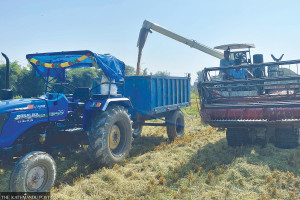Money
Paddy price hiked to Rs2,460.57 per quintal
The Cabinet has approved the minimum support price (MSP) of paddy for this fiscal year. This is the first time in three years that the government has announced the MSP before the end of the transplanting season.
The Cabinet has approved the minimum support price (MSP) of paddy for this fiscal year. This is the first time in three years that the government has announced the MSP before the end of the transplanting season.
Government spokesperson Gokul Banskota said on Wednesday that the Cabinet approved the MSP for the summer harvest of 2018-19. The price of common paddy has been raised to Rs2,460.57 per quintal from Rs2,438. Similarly, the floor price for ‘mota dhan’ has been pushed up to Rs2,331.22 per quintal from Rs2,247. The MSP ensures a profit of at least 30 percent for farmers.
The Ministry of Commerce and Supplies submitted the proposal to the Cabinet two weeks ago. The budget statement for the current fiscal year also said the MSP would be fixed on time to encourage farmers. The MSP is computed based on farmers’ production and transportation costs and inflation.
The MSP is an intervention by the government to protect farmers against sudden slumps in the market price. It is the rate at which the government buys farm produce when there are no other buyers in the market.
Normally, it is announced before the plantation begins as farmers make their production plans based on the rate they will get that season. “It’s been delayed, but it’s still good for the farmers considering past practices when the MSP was always announced late and was never implemented,” said agro expert Bhola Man Singh Basnet.
This year, the MSP will be crucial as paddy production is expected to break all past records given the good monsoon and timely availability of fertiliser, he said. “Surplus production may decrease prices in the market; but this year, farmers may not have to worry as they have legal prices set by the government,” Basnet said.
The MSP is the lowest legal price that can be paid for farmers’ harvests. The government does not fix the floor price of fine paddy.
The government has to buy at least 2 percent of the total paddy harvest under the scheme.
In 2017-2018, although the advisory body of the Agriculture Ministry had recommended the MSP, it was never implemented as the proposal of the Supplies Ministry’s was sent back by the Cabinet citing provincial and federal elections. It was announced in September. Subsequently, Nepal Food Corporation (NFC) started procuring paddy from farmers by announcing the prices internally.
In 2016-17, the MSP was announced in mid-November. Lawmakers at that time said the government’s policy was ‘absurd’ because the MSP was announced in mid-November when many farmers would have already harvested and sold their paddy crops by October-end.
Moreover, it was found at that time that Nepal Food Corporation had procured paddy for less than the MSP. Lawmakers said that the MSP was supposed to be an incentive to farmers to boost output, but the floor price fixed by the government had ‘discouraged’ them instead.
In 2012, the government announced that it would resume the policy of fixing the minimum price following complaints that middlemen had been determining the market rate. It has been reported that Nepal does not have an effective MSP.
The MSP for paddy and wheat used to be announced until 1999. The practice was fully abandoned after the government launched the 20-year Agriculture Perspective Plan, according to reports.
Even when the MSP was announced, it was not much relevant as it was set well below the projected market price to protect the government from having to buy farm products if prices should tumble.
Moreover, reports said that even when support prices were announced, it was not done before the beginning of the planting season so it did not help farmers to make production decisions.




 18.12°C Kathmandu
18.12°C Kathmandu














